If your business is still using manual punch clocks, paper timesheets, or Excel spreadsheets to track employee time, you might want to consider upgrading to time tracking software.
Time tracking software is a modern solution for tracking employees’ hours that significantly improves the process of tracking time, among many other benefits. It saves managers and admins tons of time and makes running payroll quicker and easier. It also helps you reduce labor costs and prevent time theft.
In this post, we’re going to walk through everything you need to know if you’re considering adopting time tracking software: what it is, how it works, how companies use it, and the different types of time tracking software you might want to consider using.
Looking for the best time tracking software for your small business? Check out Buddy Punch. It’s an affordable and easy to use employee time tracking app with all of the features you need to track time accurately, run payroll error-free, reduce your labor costs, and prevent time theft. View all of Buddy Punch’s features, take a product tour, or start a 14-day free trial.
What is time tracking software?
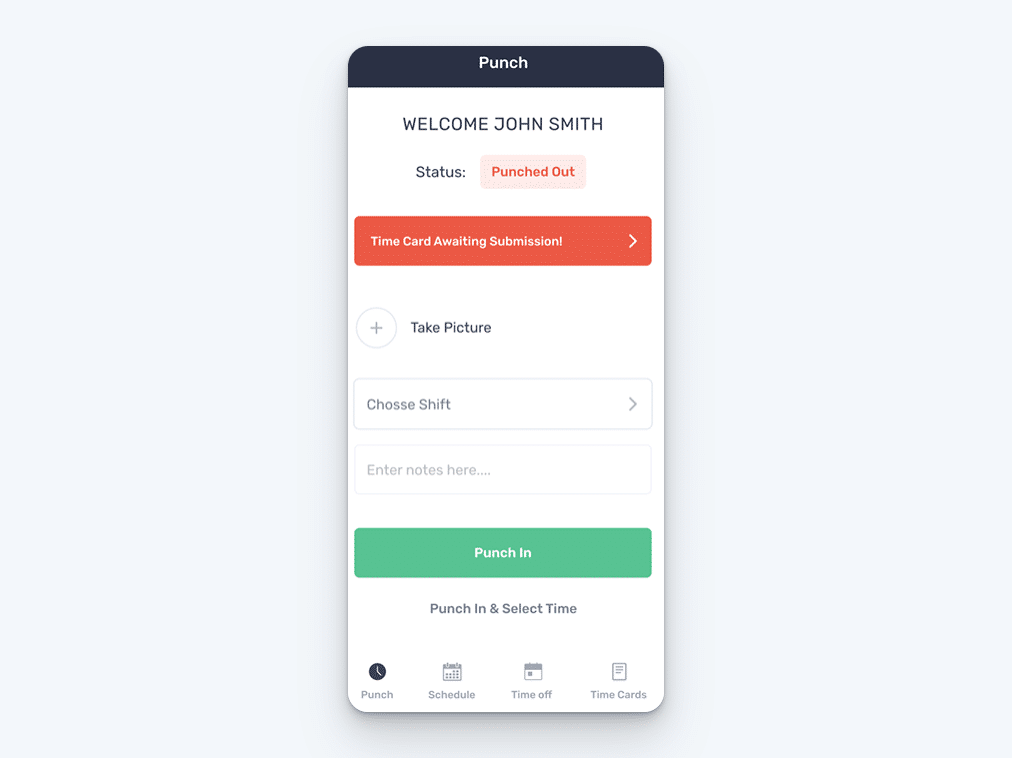
Time tracking software is a tool that helps businesses record the amount of time spent on work activities. It gives employees a way to clock into and out of work digitally, capturing the time spent on the clock — or on a specific task/project — down to the second. That data is compiled into digital timesheets that automatically calculate total hours worked.
The difference between time tracking apps and time tracking software
The terms “time tracking app” and “time tracking software” generally refer to the same types of solutions. “Apps” may refer to solutions used on mobile phones, and “software” may refer to solutions downloaded onto a computer. However, most time clock solutions offer both mobile and desktop options, so the terms are generally used interchangeably.
Other ways people refer to time tracking software
Time tracking software also goes by many other names. Other common terms include “time clock software,” “time card apps,” “clock in and out apps,” and “check-in apps.” These are all just different ways to describe digital solutions for tracking work hours.
You may also run into terms like “cloud-based” or “web-based.” The thing to note here is that all time tracking apps will have a web-based component that allows you to access the app via a URL, and nearly all web-based apps (unless they’re self-hosted) store your data on the cloud.
How does time tracking software work?
Time tracking software works through a combination of user inputs and automated processes.
User inputs include things like:
- Employees clocking in at the beginning of a shift.
- Employees clocking out for a break.
- Employees clocking back in after a break.
- Employees switching from working on one project/task to another.
- Employees clocking out at the end of a shift.
After that, automated processes come into play. Time clock software compiles all clock-in and out data into individual timesheets. Those timesheets automatically calculate the total number of regular and overtime hours worked. And if you’re tracking hours by project, it will also calculate the time spent on specific tasks, clients, or projects.
Those timesheets can be reviewed, edited, and approved if necessary. Finally, the timesheet data can be downloaded as reports or exported to payroll or invoicing software to either pay employees for the time they worked or get paid for time spent on client work.
What are the different types of time tracking software?
All time tracking software has essential features like clocking in and out, timesheets, and time card approvals. But most also have advanced features that cater to different types of teams. Some are designed for field teams, some for in-person workers, and some for remote workers.
Many also offer features that simplify other aspects of workforce management, such as payroll processing, paid time off tracking, team communication, and employee scheduling.
The right app for your team will have features catered to how your employees work, the systems you want to streamline and automate, and the data you care most about collecting.
Here are the main types of time tracking software.
Time and location tracking apps
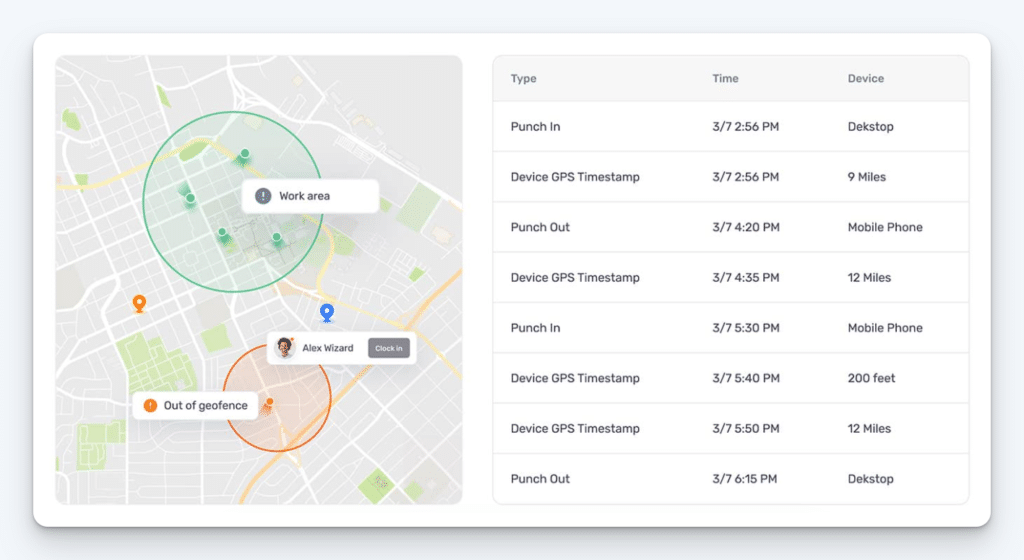
Employee location tracking apps are great for businesses with traveling employees and/or field workers who may or may not come into the office at the beginning and end of their shifts. Employees can use an app on their mobile phones to clock in and out of work from anywhere.
These apps come with features like GPS tracking and geofence time tracking that let you ensure employees are at the right job sites when they clock in and out. Some also include real-time GPS tracking that will track employees’ locations over the entire day and show you all employees’ locations at any time on a map.
Time and productivity tracking apps
Time tracking apps with productivity tracking features are designed for businesses with employees who do most or all of their work on computers.
In addition to tracking time, these apps have features that monitor what employees are doing on their computers over the course of a shift so you can identify who’s spending time on non-work activities. Some of the features included in productivity-tracking apps include:
- Screenshots: Capture pictures of employees’ computer screens at random intervals.
- App and website tracking: See how much time employees spend on specific work- or non-work-related websites and apps.
- Idle detection: Track how much time employees spend logging time but not moving their mouse or using their keyboard to do any work.
Biometric timekeeping software

Biometric timekeeping systems come with features like facial recognition, fingerprint scanning, and/or voice recognition that prevent employees from clocking in and out when the system can’t validate their identities.
There are two main use cases for biometric time clock apps:
- When buddy punching is a major problem: Biometric identification ensures that employees can never clock in and out for one another.
- When you want to speed up clocking in and out at a kiosk: Employees having to enter usernames and passwords at a time clock kiosk can create long lines for clocking in and out. Using biometric verification speeds up this process significantly.
Industry-specific time tracking software

Some time tracking apps are designed to only be used by companies in specific industries. They have features that wouldn’t be useful to companies in other industries, such as DCAA compliance for government contractors, heavy equipment tracking for construction companies, or LEDES invoice formats for law firms and lawyers.
If time tracking is more complex in your industry and you’re finding that the more general time tracking apps are missing the features you need, looking for an option that caters solely to your industry may solve the problems you’re running into.
Project time tracking apps
Some apps function as a combined time tracking and project management system. In addition to tracking employees’ hours overall, these apps can track hours spent on specific jobs or projects — and on billable and non-billable activities.
These apps may integrate with popular project management systems, or they may bring project management and time-tracking into one consolidated system, offering features like:
- Project planning, budgeting, and tracking.
- Team collaboration features like commenting and assigning.
- Gantt charts, Kanban boards, to-do lists, etc.
Additionally, many of these apps offer invoicing services, allowing you to create client invoices quickly and easily using your time-tracking data.
Time tracking and payroll software
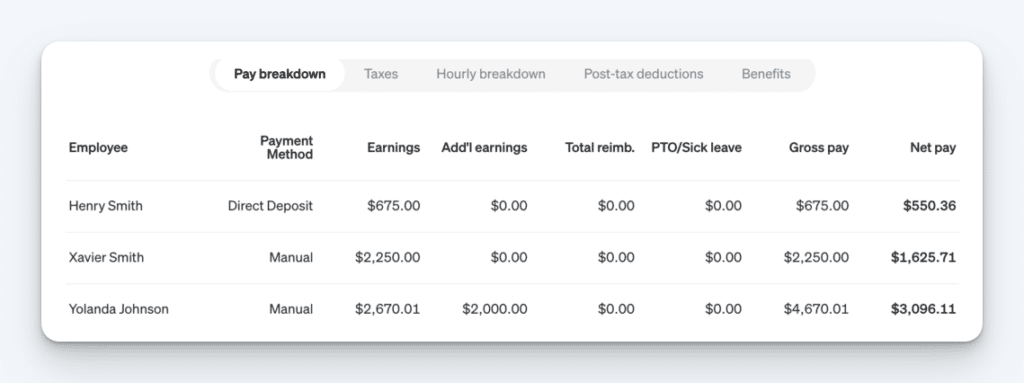
All employee time clock software will let you download time tracking reports that you can send to an existing payroll provider. Most also offer integrations with existing payroll providers where you can connect the two systems to pass timesheet reports to payroll either automatically or manually.
However, some time tracking apps offer both time tracking and payroll services, eliminating the need to pass data between two systems. Instead, you track employee hours and run payroll using the same application, saving you the extra step of transferring time data to payroll.
HR systems with time tracking features
For businesses looking to run all of their HR functions through the same system, you may want to look for a human capital management (HCM) system — also commonly referred to as a human resources information system (HRIS) or human resources management system (HRMS).
These systems bring all HR functions under one roof. In addition to time tracking software features, you’ll get access to features that help you hire and onboard new employees, run payroll, document policies and procedures, offboard employees, manage performance reviews, run employee surveys, manage benefits, and more.
These systems are generally significantly more expensive than basic time tracking software but can be worth the added expense if it helps you consolidate multiple subscriptions into one.
Time tracking and team communication apps
Finally, there are systems that combine time tracking and team communication features. This allows you to use the system to track employees’ hours, communicate with your team, and enable communication between your team members (think time tracking plus Slack, Microsoft Teams, Google Chat, WhatsApp, or Discord).
Features to look for in time tracking software
The specific features you’ll want to look for will depend on how you run your business and what problems you’re trying to solve. However, there are some must-have features that every business needs to make sure that their time tracking software provides:
- Automatic timesheets: The apps that will save you the most time and prevent the most payroll errors are those that compile timesheets for you and automatically calculate total regular and overtime hours per employee.
- Time card editing: You’ll want to be able to edit timesheets in the case of missed punches, but you may also want to look for options like duration entry for salaried employees who need to log their hours but don’t actually need to clock in and out.
- Historical time card reports: Staying compliant with federal laws means keeping historical records of employees’ timesheets. You should be aware that some of the free time clock apps will not let you download timesheet reports or access historical data.
- Payroll transfer: At the very least, you should be able to download reports you can send to your payroll provider. However, you’ll ideally want a solution that integrates with your payroll provider so your timesheet data can be transferred to payroll automatically.
Additionally, while it might seem obvious, you’ll need a way for employees to reliably clock in/out. That means making sure the app you choose accommodates how your employees work:
- If they work in the field, you’ll need something with mobile apps for on-the-go access.
- If they all work in-person, you may want to set up a time clock kiosk.
- If they don’t have email addresses, you may need to look for an option that lets you create accounts for employees without requiring unique emails for each one.
- If they work in places where internet and cell service is unavailable or unreliable, you’ll need something with offline access.
Consider these the baseline features to expect from even the most basic time tracking software. Then, you can start to consider the more advanced features you might need, such as GPS tracking, URL monitoring, facial recognition, and automatic time tracking.
How to implement time tracking software at your business
After you’ve selected the time tracking software you want your team to use, follow these steps to make sure you have everything in place to make your new system successful.
Create a timekeeping policy
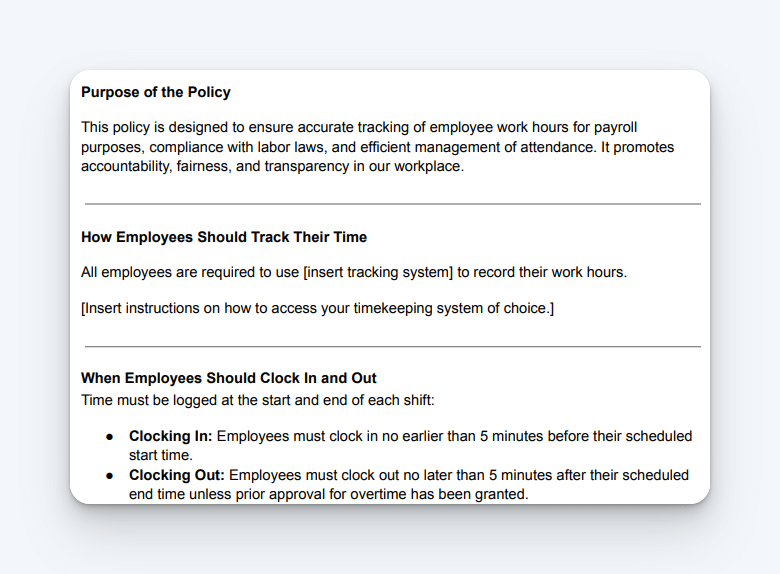
Your timekeeping policy will impact how you set up your new time tracking app, so you’ll want to make sure you’ve made all of the necessary decisions ahead of time. You’ll want to consider:
- If you’ll pay employees for their breaks.
- What overtime policies should apply to each employee.
- What projects/jobs/customers you’ll want employees to be able to log time to.
- What rates your employees will earn (and if those rates will ever be variable).
- How employees will accrue time off.
Defining these policies upfront helps you ensure that you set up your system to accommodate your policies before you roll the new system out to your team.
Set your system up to accommodate your policies
Now that you know everything you need to set up in your new system, you can start setting the system up. Enter your employees into the system, set up project codes for your different clients, enter pay rates, connect variable pay rates to specific projects, and enable or disable features you do/don’t want to use.
Determine how you’ll get your time data to your payroll provider
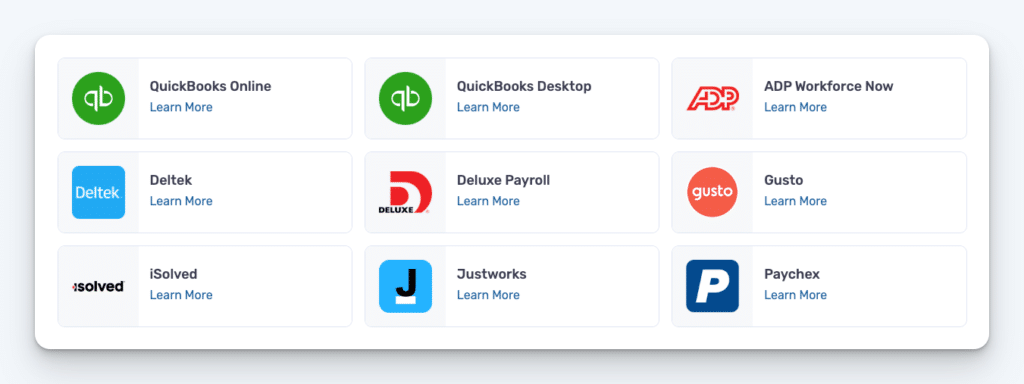
Next, you’ll need to decide how you will get that data to your payroll provider. There are a few options for how you can do this.
- Download a report from your time clock app: Your app will have a reporting function that allows you to easily download a CSV file for the appropriate pay period. Just download that report and upload it to your payroll provider. Their system will parse the file and automatically add the correct values for you.
- Send the data automatically: Most time clock apps offer built-in integrations with popular payroll providers. With an integration, you can simply click a button to send your time data to your payroll provider. It takes only seconds and prevents a lot of the mistakes that can occur as a result of incorrect setup or formatting when uploading the data via a spreadsheet.
- Use the time clock’s built-in payroll function: The easiest way to connect your time data to payroll is to use your time clock’s built-in payroll service. It will automatically pull your team’s timesheets over when it’s time to run payroll and take care of employee and tax payments, deductions, etc. for you.
Roll your new system out to your team
Once you’ve completed all of the steps above, you’re finished with the administrative setup work and can move on to getting your team acclimated to and using your new system.
In every organization, there are always a few employees who are resistant to change and will have a difficult time adopting a new solution. To ease their anxiety, follow these tips:
- Do a slow roll-out: Instead of introducing the new tool to everyone at once, roll it out first with a few employees who are willing to help. This will help you identify where people are going to run into issues and work out any kinks before everyone is using it.
- Create guidelines and training materials: Employees will abandon time tracking if they don’t understand how to use it. Create short, simple, and clear instructions, and house them somewhere that’s easy for employees to reference.
- Hold training sessions: Host training sessions for all employees before asking them to use the new time clock. Presentations can work, but it’s better to run demos so employees can learn by doing.
- Encourage feedback: Ask your team regularly how they feel about the time tracking app and process. Soliciting feedback makes employees feel heard and helps you optimize your procedures to be more effective.
Finally, make sure to communicate why using the app — and tracking time in general — is important. Reframe the discussion by focusing on the benefits for your employees.
When employees understand that the ultimate goal is to make sure they’re paid on time and properly, they’ll be much more likely to be willing to adapt to the change.

